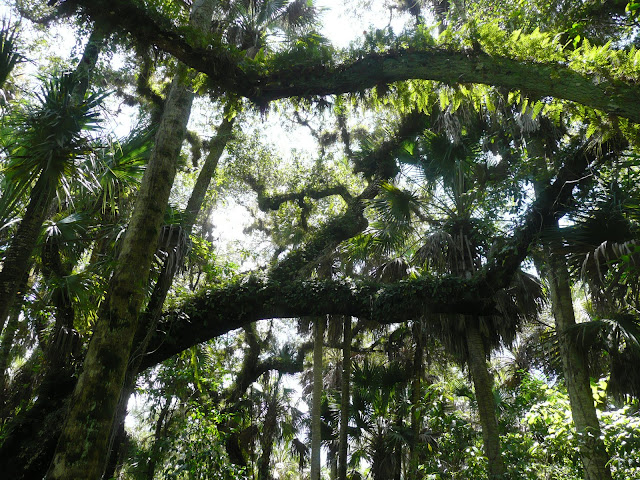Wednesday, August 10th
Made a return visit to the Everglades Agricultural Area in the company of master birders Vince Lucas, who lead the trip, Jose Padilla and wildlife photographer Bob Pelkey. Just a week ago I ventured solo, sans scope, and was rewarded with a a Lifer in Wilson's Phalarope. My personal goals for the day are to add upland sandpiper, barn owl and cliff swallows, which I missed last week.
Vince has birded the EAA many times in the past and would lead our party. It was a long day, starting at 4:30 am to make the 2 hour plus trip to Palm Beach County. After sunrise, we started adding bird as we passed through Hendry County such as Common Nighthawks, American Crows, Black Vultures, Crested Caracara, Swallow-tailed Kites, Sandhill Cranes, Mourning Doves, Eurasian Collared Doves, Ground Doves, Osprey, Red Shouldered Hawks and Grackles.
 |
| The Cedar Stand owl roost |
First stop was the 'Cedar Stand' located along the Miami Canal. We had already located Barn Swallows, an early Tree Swallow, Purple Martin and Eastern Meadowlarks along the canal and at the stand, Vince found us four Barn Owls, five Black-crowned Nightherons, plus some roosting Black Vultures. Barn owls have been a nemesis bird for me, which I have dipped on at this location, and elsewhere, several times. So for me I they were a Lifer.
We moved onto the King Ranch sod fields along US 27, were Bob caught-up with us. Here we had four Upland Sandpipers and a few Pectoral Sandpipers and Killdeers.
An extremely active location was a site 1.5 miles east of Duda Road along cr-880. This flooded field had to contain 2,500 plus birds - waders, shorebirds, terns, gulls, swallows etc.. Here we found that good numbers of Wilson's Phalaropes were still present. We counted at least fifteen, which is a good number for Florida. As these birds concentrate their fall migration further west from here. I did have a scope view which initially began with four of the birds doing their spinning, expanding to eight phalaropes in the one view. Other sighting here included Roseate Spoonbills, American Avocets, Black-necked Stilts, Pectoral Sandpipers, Stilt Sandpipers, Mottled Ducks, Least Sandpipers, Semipalmated Sandpipers, Long-billed Dowitchers, Black terns, Black Skimmers, Least Tern, Caspian Terns, Forster's Terns and Gull-billed Terns
 |
| Bob Pelkey looking for that perfect shot |
 |
| Sod fields at Six Mile Farms were we located lots of Upland Sandpipers |
At the nearby Six Mile Bend Sod Farms, we could spot several
Upland Sandpipers, but they were quite distant. Luckily we were given permission to enter the property and were able to get much closer views. Still only Bob's camera rig could possibly get a decent photograph because they are skittish birds and still kept a good distance. Be sure to check-out Bob's blog on this trip and enjoy his photography. Our Uplands count here were sixteen birds. We also had several
Cattle Egrets, some
White Ibis, Pectoral Sandpiper, Killdeer, Laughing Gulls and a
Spotted Sandpiper.
 |
| Vince Lucas and Dr Jose Padilla trying to get the numbers off the spoonbills' leg bands |
Also nearby, off the first bridge on Brown's Farm Road was another good flooded field. Had to be 150 Roseate Spoonbills. Vince noted three had leg bands, but we were unable to get any numbers off them. Also seen among the
Great Egrets was
a Great White Heron ( the white-morph of the great blue heron ). Other birds present included
Snowy Egrets, Tricolored Heron, Wood Storks, American Avocets, Black-necked Stilts, a Black-bellied Whistling Duck, Semipalmated Plovers, Pectoral Sandpipers, Long-billed and Short-billed dowitchers, Green Heron, Forster's Tern, Black Terns, Gull-billed Terns, Least Tern, several
Semipalmated Sandpipers, a Ruddy Turnstone, lots of
Barn Swallows, Bank Swallows, and the
Cliff Swallows I wanted to add today.
We wrapped up the EAA trip with stops at Sam Senter and Gladeview Roads. Here we were able to add more Black-bellied Whistling Ducks and had a a few Fulvous Whistling Ducks, including a duckling. Also had a couple of Black-bellied Plovers and flock of about a hundred Brown-headed Cowbirds
The actual final stop was on Oil Well Road, near Ava Maria University, in Collier County, were Vince had found a flooded spot with lots of birds. Recent rains have deeped the water level, so most of the shorebirds were absent now, except for Black-necked Stilts, Glossy Ibis, White Ibis and a few dowitchers and Pectoral Sandpipers. Present were most of the waders, about fifty Mottled Ducks and several Wood Ducks. A couple Swallow-tailed Kites were soaring nearby and we were able to add a couple Limpkins on the trip back to Gulf Coast.
It was a great and exhausting trip. Hit all of my goals on an incredible day of birding. Thanks to Vince, Jose and Bob for a fun day.
Day's List (73)
Black-bellied Whistling-Duck, Fulvous Whistling-Duck, Wood Duck, Mottled Duck, Wood Stork, Double-crested Cormorant, Anhinga, Great Blue Heron, Great White Heron, Great Egret, Snowy Egret, Little Blue Heron, Tricolored Heron, Cattle Egret, Green Heron, Black-crowned Night-Heron, White Ibis, Glossy Ibis, Roseate Spoonbill, Black Vulture, Turkey Vulture, Osprey, Swallow-tailed Kite, Red-shouldered Hawk, Crested Caracara, Common Gallinule, Sandhill Crane, Black-bellied Plover, Semipalmated Plover, Killdeer, Black-necked Stilt, American Avocet, Spotted Sandpiper, Greater Yellowlegs, Lesser Yellowlegs, Upland Sandpiper, Semipalmated Sandpiper, Least Sandpiper, Pectoral Sandpiper, Stilt Sandpiper, Short-billed Dowitcher, Long-billed Dowitcher, Wilson's Phalarope, Laughing Gull, Least Tern, Gull-billed Tern, Caspian Tern, Black Tern, Forster's Tern, Black Skimmer, Rock Pigeon, Eurasian Collared-Dove, Mourning Dove, Common Ground-Dove, Barn Owl, Common Nighthawk, Loggerhead Shrike, American Crow, Purple Martin, Tree Swallow, Bank Swallow, Cliff Swallow, Northern Mockingbird, European Starling, Northern Cardinal, Red-winged Blackbird, Eastern Meadowlark, Common Grackle, Boat-tailed Grackle, Brown-headed Cowbird, House Sparrow





























